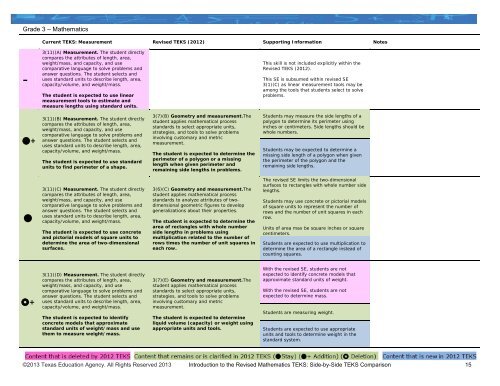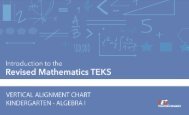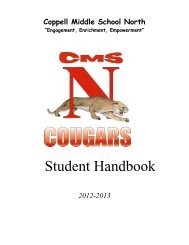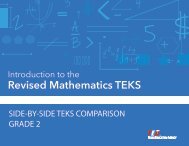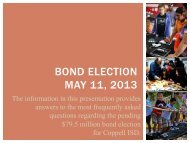SIDE-BY-SIDE TEKS COMPARISON GRADE 3 - Project Share
SIDE-BY-SIDE TEKS COMPARISON GRADE 3 - Project Share
SIDE-BY-SIDE TEKS COMPARISON GRADE 3 - Project Share
You also want an ePaper? Increase the reach of your titles
YUMPU automatically turns print PDFs into web optimized ePapers that Google loves.
Grade 3 – MathematicsCurrent <strong>TEKS</strong>: Measurement Revised <strong>TEKS</strong> (2012) Supporting Information Notes–3(11)(A) Measurement. The student directlycompares the attributes of length, area,weight/mass, and capacity, and usecomparative language to solve problems andanswer questions. The student selects anduses standard units to describe length, area,capacity/volume, and weight/mass.The student is expected to use linearmeasurement tools to estimate andmeasure lengths using standard units.This skill is not included explicitly within theRevised <strong>TEKS</strong> (2012).This SE is subsumed within revised SE3(1)(C) as linear measurement tools may beamong the tools that students select to solveproblems.+3(11)(B) Measurement. The student directlycompares the attributes of length, area,weight/mass, and capacity, and usecomparative language to solve problems andanswer questions. The student selects anduses standard units to describe length, area,capacity/volume, and weight/mass.The student is expected to use standardunits to find perimeter of a shape.3(7)(B) Geometry and measurement.Thestudent applies mathematical processstandards to select appropriate units,strategies, and tools to solve problemsinvolving customary and metricmeasurement.The student is expected to determine theperimeter of a polygon or a missinglength when given perimeter andremaining side lengths in problems.Students may measure the side lengths of apolygon to determine its perimeter usinginches or centimeters. Side lengths should bewhole numbers.Students may be expected to determine amissing side length of a polygon when giventhe perimeter of the polygon and theremaining side lengths.3(11)(C) Measurement. The student directlycompares the attributes of length, area,weight/mass, and capacity, and usecomparative language to solve problems andanswer questions. The student selects anduses standard units to describe length, area,• capacity/volume, and weight/mass.The student is expected to use concreteand pictorial models of square units todetermine the area of two-dimensionalsurfaces.3(6)(C) Geometry and measurement.Thestudent applies mathematical processstandards to analyze attributes of twodimensionalgeometric figures to developgeneralizations about their properties.The student is expected to determine thearea of rectangles with whole numberside lengths in problems usingmultiplication related to the number ofrows times the number of unit squares ineach row.The revised SE limits the two-dimensionalsurfaces to rectangles with whole number sidelengths.Students may use concrete or pictorial modelsof square units to represent the number ofrows and the number of unit squares in eachrow.Units of area may be square inches or squarecentimeters.Students are expected to use multiplication todetermine the area of a rectangle instead ofcounting squares.+3(11)(D) Measurement. The student directlycompares the attributes of length, area,weight/mass, and capacity, and usecomparative language to solve problems andanswer questions. The student selects anduses standard units to describe length, area,capacity/volume, and weight/mass.The student is expected to identifyconcrete models that approximatestandard units of weight/mass and usethem to measure weight/mass.3(7)(E) Geometry and measurement.Thestudent applies mathematical processstandards to select appropriate units,strategies, and tools to solve problemsinvolving customary and metricmeasurement.The student is expected to determineliquid volume (capacity) or weight usingappropriate units and tools.With the revised SE, students are notexpected to identify concrete models thatapproximate standard units of weight.With the revised SE, students are notexpected to determine mass.Students are measuring weight.Students are expected to use appropriateunits and tools to determine weight in thestandard system.©2013 Texas Education Agency. All Rights Reserved 2013 Introduction to the Revised Mathematics <strong>TEKS</strong>: Side-by-Side <strong>TEKS</strong> Comparison 15


